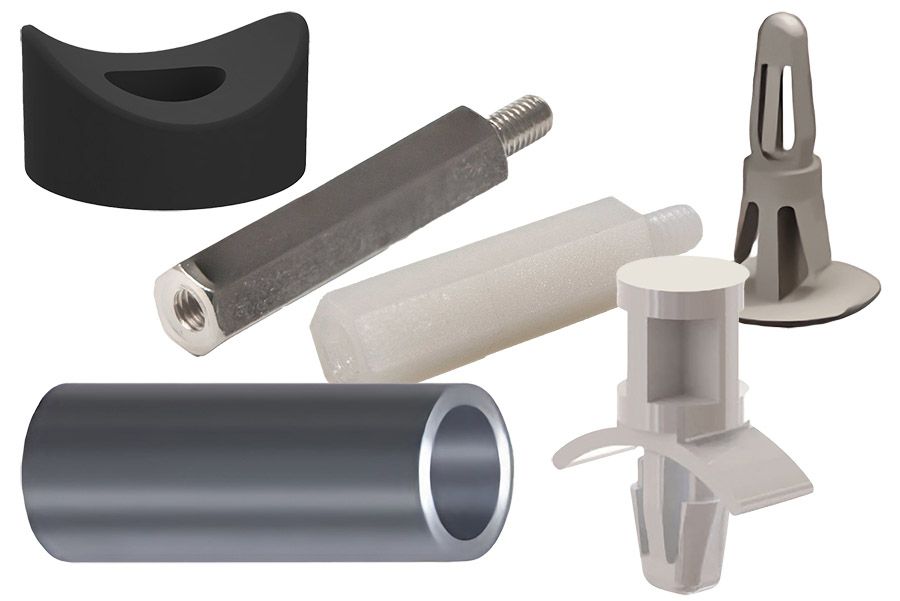
Spacers are a much-used product in industries such as construction, engineering, and manufacturing.
For buyers not familiar with spacers and the many considerations involved in their purchase, it’s hoped that the following information will be found helpful.
What exactly is a spacer?
A spacer is a device or material used to create a specific distance between two objects or surfaces. Spacers are commonly used in to ensure that parts are properly aligned and positioned.
What are some of the typical uses for spacers?
Spacers are used for various purposes, including;
- Maintaining a specific distance between two objects or surfaces.
- Providing thermal insulation or electrical isolation.
- Reducing vibration or noise.
- Supporting weight or pressure.
- Creating a gap for the installation of fasteners or connectors.
What are the main advantages of spacers?
The advantages of spacers include their ability to improve accuracy and precision, reduce wear and tear, and increase efficiency. They can also provide thermal insulation and electrical isolation, which can be crucial in certain applications.
What are the main types of spacers?
There are various types of spacers, including:
- Metal spacers - commonly made from materials like steel, aluminium, or brass
- Plastic spacers - made from materials like PVC, nylon, or polyethylene
- Ceramic spacers - used in high-temperature applications
- Glass spacers - used in insulated glass windows and doors
- Rubber spacers - used to reduce vibration and noise
What are the advantages of plastic spacers?
The advantages of plastic spacers include their lightweight, corrosion resistance, and ability to be easily moulded into various shapes and sizes. Plastic spacers are also generally less expensive than metal spacers and can be more resistant to certain chemicals and environmental factors.
Spacer sizes
Spacer sizes can vary greatly depending on their intended use, from small spacers used in electronics to larger spacers used in construction and engineering applications. The size of a spacer should be carefully chosen to ensure that it provides the necessary support and distance required for the specific application
What should I consider before purchasing spacers?
When buying spacers, there are several important things to consider;
- Material: Different materials have different properties, so it is important to choose a material that is suitable for the intended application. For example, if the spacer will be exposed to high temperatures, a ceramic or metal spacer may be more appropriate than a plastic spacer.
- Size: Apart from ensuring that the spacer provides the necessary support and distance required for the specific application, it’s important to consider the thickness, diameter, and length of the spacer.
- Load capacity: The spacer should be able to support the weight or pressure that it will be subjected to. It is important to choose a spacer with a load capacity that is appropriate for the application.
- Tolerance: The tolerance of the spacer refers to the degree of precision with which it is manufactured. It is important to choose a spacer with a tolerance that is suitable for the application. For example, if the spacer is used in a high-precision application, it may be necessary to choose a spacer with a tight tolerance.
- Compatibility: The spacer should be compatible with the other components in the assembly. It is important to choose a spacer that is compatible with the materials and dimensions of the other parts.
- Quantity: The number of spacers required for the application should be considered, as well as any discounts that may be available for larger quantities.
Thinking about plastic spacers? Here’s some additional information.
As mentioned previously, plastic spacers are generally more resistant to certain chemicals and environmental factors than metal spacers. Some of the chemicals and environmental factors that plastic spacers may be more resistant to include;
- Corrosion: Plastic spacers are not subject to corrosion like metal spacers are. This makes them a good choice for applications where corrosion is a concern, such as in marine or outdoor environments.
- Chemicals: Plastic spacers are more resistant to certain chemicals than metal spacers. For example, plastic spacers are generally more resistant to acids, alkalis, and organic solvents.
- Moisture: Plastic spacers are generally more resistant to moisture than metal spacers. This makes them a good choice for applications where moisture is a concern, such as in humid environments or when exposed to water.
- UV radiation: Plastic spacers are generally more resistant to UV radiation than metal spacers. This makes them a good choice for applications where exposure to sunlight or other sources of UV radiation is a concern.
However, it is important to note that not all plastic spacers are the same and their resistance to specific chemicals and environmental factors may vary depending on the type of plastic used. It is important to choose a plastic spacer that is suitable for the specific application and the environment in which it will be used.
Here are some general guidelines for when to use PVC, nylon, or polyethylene spacers;
PVC spacers
PVC spacers are often used in applications where high strength and rigidity are required. PVC spacers are also resistant to UV radiation, chemicals, and moisture, making them suitable for outdoor use.
However, PVC spacers may not be suitable for high-temperature applications, as they tend to soften and deform at elevated temperatures.
Nylon spacers
Nylon spacers are lightweight, durable, and resistant to wear and tear. Nylon spacers are also self-lubricating, making them suitable for applications that involve high speeds and low friction.
Nylon spacers are often used in applications where resistance to impact and vibration is required. However, nylon spacers may not be suitable for high-temperature applications, as they tend to soften and deform at elevated temperatures.
Polyethylene spacers
Polyethylene spacers are lightweight, chemically resistant, and have good electrical insulation properties. Polyethylene spacers are often used in applications where low friction and low moisture absorption are required.
Polyethylene spacers are also suitable for outdoor use, as they are resistant to UV radiation. However, polyethylene spacers may not be suitable for high-temperature applications, as they tend to soften and deform at elevated temperatures.
In summary, PVC spacers are best suited for applications that require high strength and rigidity, nylon spacers are best suited for applications that require resistance to wear and tear, and polyethylene spacers are best suited for applications that require low friction and low moisture absorption.
Ultimately, the choice of spacer material will depend on the specific application requirements and environmental conditions.
Our team of specialists at NPA would be only too happy to discuss your spacer requirements with you.
Call us today on (08) 8268 2733 or visit our online store by clicking here.
View other products in the NPA Buyer’s Guide Series:

